International Journal of Scientific & Engineering Research, Volume 5, Issue 6, June-2014 470
ISSN 2229-5518
Mechanical Characterization & SEM Analysis of
Calcium Silicate Reinforced Polyester Laminate
Asst. Prof /Dr /Dr /Mr. Puttaswamaiah.S 1 / Mir Shafiulla 2 / Mohamed Haneef 3/ Mahesh R Hallur 4
ABSTRACT: The aim of this work is to determine & compare the mechanical characterization such as tensile test, compression & flexure test of calcium silicate mixed with polyester resin lamina. It is well known that inorganic filler particles enhance the mechanical properties of polymers. Calcium silicate with different percentage is added to the resin material in order to enhance the mechanical property. Calcium silicate helps the polyester resin to get the hardness to the certain level higher than the individual polyester resin. The Calcium Silicate (CaSiOR3R ) is available in powder form and is known for its high strength & hardness. Test Specimen is prepared with different composition of calcium silicate in polyester resin. The results have been plotted & compared. The morphology of the calcium silicate added polyester resin laminate are observed in Scanning electron microscope. The surface morphology of the laminates reveals that well distributed particles of calcium silicate.
KEYWORDS: Polymer matrix, calcium silicate /polyester composite, Mechanical characterization of PMC’s.
For over 50 years, fiber-reinforced plastic (FRP) materials have proven to be very successful in structural applications. They are widely used in the aerospace, automotive and marine industries. Fillers added polymer composites show increase in the mechanical properties like tensile strength, Young’s modulus and elongation [1]. Yoshida, et al. showed that the addition of silica in a particular composition of the composite materials increases the tensile strength of materials [2]. Composite laminates are used in many industries because they possess high stiffness to weight ratios, high strength to weight ratios, resistance to fatigue and corrosion, and low coefficients of thermal expansion. Hence the composite is added with some chemical compound which will give the mechanical strength among the composite. Hence the composite laminate is added with calcium silicate along with polyester resin. Polyester resins have a good balance of mechanical, electrical and chemical properties. The polyester resins are mainly used in glass fibre profiles. The calcium silicate is added to the polyester resin in different percentage in order to determine the best performance of the sample. Addition of nano particles will produces a new class of composites that exhibits a high physical, thermal and mechanical properties compared to that of conventional composites due to strong interfacial interaction between particles and the resin matrix![]()
1 - Asst. Professor, Dept of Mechanical Engg, EWIT, Bangalore.
2 -Professor, Dept of Mechanical Engg & Head of R&D, GCE, Ramanagara
3 - Principal ,GCE, Ramanagaram.
4 - PG Student (Product Design & Manufacturing), Dept of IEM, JSSATE, Bangalore. (Maheshhallur2@gmail.com).
The addition of ceramic reinforced material, SiC particles, to resin matrices, results in the improvement of the overall performance of the composite, allowing the application
of these materials as tribo-materials in industries such as:
automotive, aeronautical and medical. Used particles of size of
0.1µm to 22µm [3].
Unsaturated polyester (UPR 108) used as polymer matrix of composite in addition of methyl ethyl ketone peroxide (MEKPO) as catalytic reaction. Calcium silicate which is available commercially is used as filler in composite.
The composite laminate material used in this research was prepared using the matrix material polyester resin. Looking to the relative advantages and qualities of polyester resin and ease of availability in nearby market vicinity polyester has been selected. Along with the polyester resin chemical compound like calcium silicate is used. Both the mixture of polyester resin mixed with calcium silicate is used as a matrix material to test the strength of the matrix. With 0%,
2%, 4% and 6% of calcium silicate is used in order to compare
the mechanical properties. The specimen is prepared as per the ASTM standard for tensile, compression and bending. The more sophisticated manufacturing methods now include resin infusion, where the resin is drawn into a closed mould under vacuum. In this study, four different types of laminates were prepared from mixture of polyester resin and calcium silicate and compared for there inter molecular response or strength response. The first panel was made of polyester resin , second one with 2% of CaSiOR3,R 3rd with 4% of CaSiOR3 Rand 4th with 6% of CaSiOR3R. The figure 1 shows the mould which is designed to prepare the laminates. Figure 2 shows the tensile test carrying out in the UTM.
IJSER © 2014 http://www.ijser.org
International Journal of Scientific & Engineering Research, Volume 5, Issue 6, June-2014 471
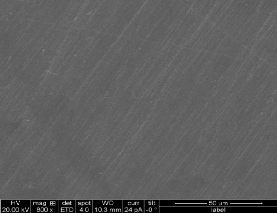
ISSN 2229-5518
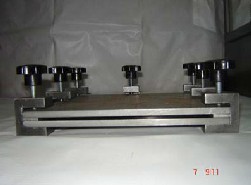
Figure 1 : Mould box to manufacture laminates
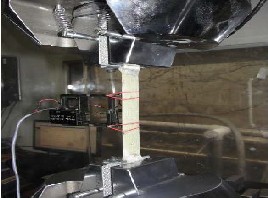
Mechanical properties of composite were performed by UTM according to ASTM D-638 at room temperature and crosshead speed of 1 mm/min. prior to tensile test, dumbbell- shaped specimens were cut for each film according to ASTM D638, type V in dimension of 250 x 20 x 4 mm3. The hardness of the specimen was determined by using the Vickers’s micro hardness. The surface of sample was put on the surface of a sample holder and then coated with gold for electron microscopy measurement. Morphological surface of cross- sectional surface of composite was analyzed by scanning electron microscope (SEM), ESEM QUANTA 200, FEI, operated at accelerating voltage of 20 kV. Further characterization, i.e. compression, bending & hardness were also performed on the laminate.
Figure 2 : Tensile testing machine.
Figure 3 : SEM Images of 0% CaSiO 3
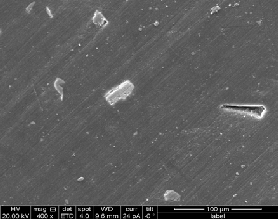
Figure 4: SEM image of 2% CaSiO 3
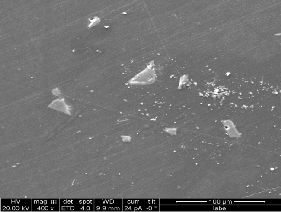
Figure 5: SEM image of 4% CaSiO 3
IJSER © 2014 http://www.ijser.org
International Journal of Scientific & Engineering Research, Volume 5, Issue 6, June-2014 472
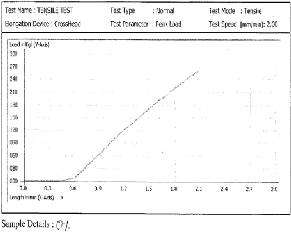
ISSN 2229-5518
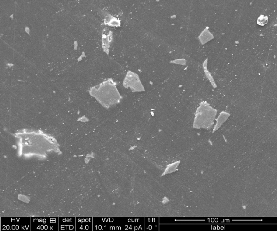
Figure 6 : SEM image of 6% CaSiO 3
The laminates which are prepared by adding calcium silicate to polyester resin are observed under scanning electron microscope to study the morphology of distribution of calcium silicate particles inside the resin
The SEM image of the pure polyester resin laminate is show in the figure 3. Since it is pure resin material laminate no calcium silicate particles are seen or observed
The SEM morphology of 2%, 4% & 6% of calcium silicate added polyester resin laminate is shown in figure 4,5 &
6 .It is observed from the figures that the distribution of the calcium silicate in the polyester is non uniform and the size of the calcium silicate particles are of the size of 30µm to 50µm.
The morphology of the SEM revealed that the shapes of the calcium silicate particles are irregular. And also the sizes of the particles were also irregular.
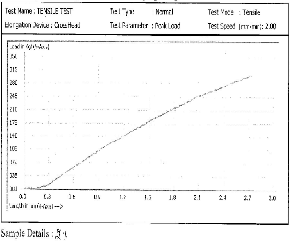
Figure 7 : For 0% CaSiO 3
Figure 8 : For 2% CaSiO 3
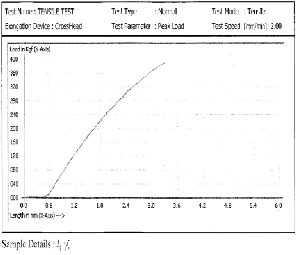
Figure 9 : For 4% CaSiO 3
IJSER © 2014 http://www.ijser.org
International Journal of Scientific & Engineering Research, Volume 5, Issue 6, June-2014 473
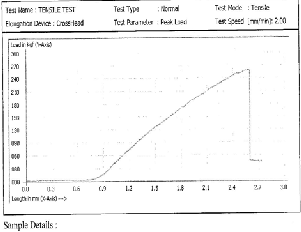
ISSN 2229-5518
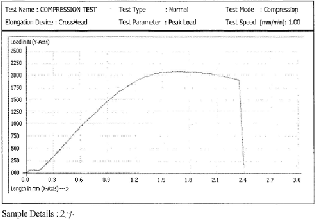
Figure 10 : For 6% CaSiO 3
Samples | CaSiO3 in matrix | Peak Load (N) | %Elongation | Break Load (N) |
1 | 0% | 2568 | 1.05 | 2562 |
2 | 2% | 2953 | 2.27 | 2945 |
3 | 4% | 3822 | 2.67 | 3814 |
4 | 6% | 2728 | 2.66 | 2682 |
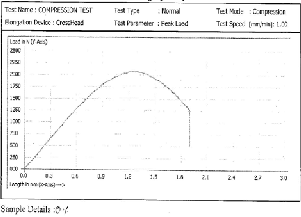
Figure 11 : For 0% CaSiO 3
Figure 12 : For 2% CaSiO 3
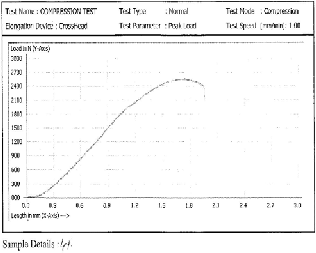
Figure 13 : For 4% CaSiO 3
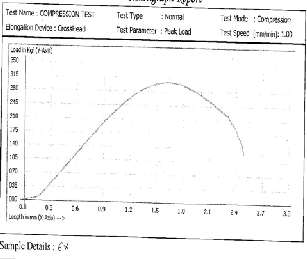
Figure 14 : For 6% CaSiO 3
IJSER © 2014 http://www.ijser.org
International Journal of Scientific & Engineering Research, Volume 5, Issue 6, June-2014 474
ISSN 2229-5518
Samples | CaSiO3 in matrix | Peak Load (N) | %Elongation | Break Load (N) |
1 | 0% | 2072 | 1.25 | 1292.28 |
2 | 2% | 2078 | 2.35 | 1282 |
3 | 4% | 2547 | 1.75 | 1484 |
4 | 6% | 2969 | 1.75 | 1155 |
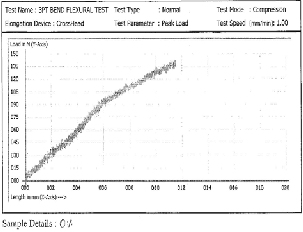
specimen of polyester composite with 0%, 2%,4% and 6%of calcium silicate with test speed of 1mm/min and the results are noted down. And the graph is generated for the tested values.
Figure 15 : For 0% CaSiO 3

Figure 16 : For 2% CaSiO 3
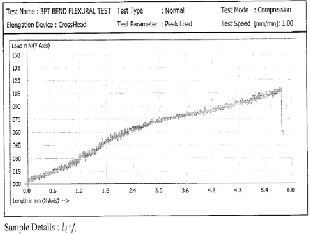
Figure 17 : For 4% CaSiO 3
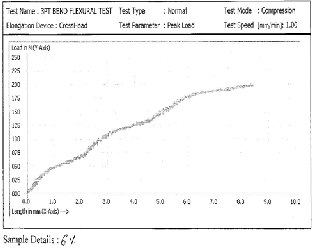
Figure 18 : For 6% CaSiO 3
IJSER © 2014 http://www.ijser.org
International Journal of Scientific & Engineering Research, Volume 5, Issue 6, June-2014 475
ISSN 2229-5518
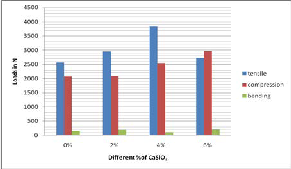
The hardness of the specimen of polyester lamina and different percentage of calcium silicate added polyester lamina is determined by the Vickers micro hardness test. The test was conducted on the specimen by varying the load like 25gms &
50gms.
Vickers micro hardness (HV) = (1.854*F)/d2
F= load in kgf
d=mean diagonal of indentation in mm2
Sl N o | CaSiO3 in matrix | 25g of load in kgf | 50g of load in kgf | ||
Sl N o | CaSiO3 in matrix | Mean diagona l in mm | Hardnes s in kgf/mm2 | Mean diagona l in mm | Hardnes s in kgf/mm2 |
1 | 0% | 133 | 15.7 | 187 | 15.8 |
2 | 2% | 130 | 17.1 | 180 | 17.3 |
3 | 4% | 115 | 20.8 | 161 | 20.9 |
4 | 6% | 107 | 24.1 | 150 | 24.6 |
CaSiO3 in matrix | Tensile (N) | Compression (N) | Bending (N) | Hardness (HV) |
0% | 2568 | 2074 | 142 | 15.7 |
2% | 2953 | 2078 | 187 | 17.1 |
4% | 3822 | 2547 | 111 | 20.8 |
6% | 2728 | 2970 | 202 | 24.6 |
In the tensile test we can see from the obtained graph that the load required for the composite laminae with 4% calcium silicate requires more load than that of the composit with 0%,2% and 6% calcium silicate
The elongation of the composite in the 4% composite is more when compare to that of the 0%,2% and 6% calcium silicate.
More load is required to break the composite with 4%
calcium silicate than the 0%,2% and 6%
The laminate with 4% of calcium silicate is the best for the
tensile application .
The specimen with 6% calcium silicate got highest withstanding strength, so it can be used when the application requires the maximum load to with stand.
In the compression test we can see from the obtained graph that the load required for the composite laminae with 4% calcium silicate requires more peak load than that of the composite with 0%,2% & 6% CaSiO3 .
The elongation of the composite in the 2% composite is
more when compare to that of the 0%,4% & 6%calcium silicate.
More load is required to break the composite with 6%
calcium silicate than the rest.
In the bending test we can see from the obtained graph that the load required for the composite laminae with 6% calcium silicate requires more load than that of the composite with 0%,2%& 4%calcium silicate
The elongation of the composite in the 0% composite is more when compare to that of the 6%calcium silicate.
So we can conclude that the laminae has got the brittle property after adding the calcium silicate
The values obtained from the micro hardness test which was carried out on the vicker’s micro hardness testing instrument indicates that the hardness of the specimen increases as the percentage of the calcium silicate in the polyester increases.
From the obtained graph we can observe that, to with stand the maximum tensile strength, the sample with
4% calcium silicate can be used than that of the other samples.
For the compression, the specimen with 6% of the calcium silicate withstands more loads. So the polyester resin added with 6% calcium silicate can be used.
When the application of the composite with
maximum bending strength , the composite of
polyester added with 6% of calcium silicate can be used.
IJSER © 2014 http://www.ijser.org
International Journal of Scientific & Engineering Research, Volume 5, Issue 6, June-2014 476
ISSN 2229-5518
1. “Synthesis and Characterization of Polyester-Based Nanocomposite” Sudirman, M. Anggaravidya, E. Budianta, I. Gunawan Procedia Chemistry 4 ( 2012 ) 107 –
113
2. Yoshida Y., Shirai K., Nakayama Y., Itoh M., Okazaki M., Shintani H., Inou S., Lambrechts P., Herle G.V., Merbeek V., J.Dent. Res. 2022; 4: 270-273.
3. “Mechanical and wear behaviours of nano and microfilled
polymeric composite: Effect of filler fraction and size” P.V. Antunes, A. Ramalho, E.V.P. Carrilho Materials & Design, Volume 61, September 2014, Pages 50-60
4. Introduction to Composite Materials” F.C Campbell Structural Composite Materials 2010, ASTM International..
5. Flexural Properties of Unreinforced and Reinforced Plastics and Electrical Insulation, Annual Book of ASTM Standard, ASTM D-790-81, 08.01, (2007), 403-405.
6. ASTM D 638 Test Method for Tensile Properties of
Polymer Matrix Composite Materials
7. “Thermo-mechanical properties of polysulfone based
nanocomposites with well dispersed silica nanoparticles”,
D. Olmos, S.G. Prolongo, J. González-Benito, Composites
Part B: Engineering, Volume 61, May 2014, Pages 307-
314
8. Gengcheng Y, Renrui T, Xiao P. Polymer Composite
1997;18: 477.
9. A Kafi, M Z Abedin, M D H Beg, K L Pickering and M A Khan, Study on the mechanical properties of jute/glass fiber-reinforced unsaturated polyester hybrid composites: Effect of surface modification by Ultraviolet radiation, J. Reinforced. Plastic. Composite ., 25, 575-588, 2006.
10. Comparative assessment of isophtalic and orthophtalic
polyester polymer concrete: Different costs, similar
mechanical properties and durability Construction and Building Materials, Volume 21, Issue 3, March 2007, Pages 546-555 J.P. Gorninski, D.C. Dal Molin, C.S. Kazmierczak.
11. Comparison of the mechanical properties and interfacial
interactions between talc, kaolin, and calcium carbonate filled polypropylene composites. Y. W. Leong, M. B. Abu Bakar, Z. A. Mohd. Ishak, A. Ariffin and B. Pukanszky 16
JAN 2004 DOI: 10.1002
12. The effect of filler loading and morphology on the
mechanical properties of contemporary composites .The
Journal of Prosthetic Dentistry, Volume 87, Issue 6, June
2002, Pages 642-649 Kyo-Han Kim, Joo L. Ong, Osamu
Okun
13. R A Khan, M A Khan, S Sultana, M N Khan, Q T H
Shubhra and F G Noor, Mechanical, Degradat ion and interfacial propert ies of synthet ic degradable fibre reinforced polypropylene composites, J. Reinforc. Plast . Compos., 29, 466-476, 2010.
14. A K Bledzki and J Gassan, Composites reinforced with
cellulose based fibres, J. Prog. Polym. Sci., 24, 221-274,
1999.
1 - Asst. Professor, Dept of Mechanical Engg, EWIT, Bangalore (Puttas66@gmail.com)
2 -Professor, Dept of Mechanical Engg & Head of R&D, GCE, Ramanagara (safiullamir@gmail.com)
3 - Principal ,GCE, Ramanagaram.(Principal_gce@hotmail.com)
4 - PG Student (Product Design & Manufacturing), Dept of IEM, JSSATE, Bangalore. (Maheshhallur2@gmail.com).
IJSER © 2014 http://www.ijser.org